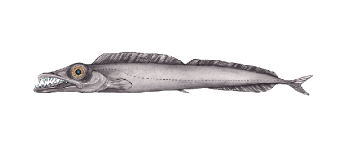
Black scabbardfish
(Aphanopus carbo)
The black scabbardfish is one of the approximately 290 deep-sea fish species caught and described off Madeira in the last 200 years. It is a well-known cuisine fish and locally known under the name espada, meaningsword in Portuguese.
The first scabbardfish was apparently brought to the surface in 1840 and landed in the pan a little later. In Madeira, scabbardfish are caught from small fishing boats with longlines extending to depths of 1,500 m.
The hooks are baited with squids to attract these deep-sea predators. It is a traditional and targeted method of fishing which in contrast to large fishing vessels produces less bycatch due to the limited time these longlines are left in the water.
Scabbards are thought to come to Madeira to spawn and feed on the variety of mesopelagic organisms.
General information
Further names: Portuguese: Espada preta
Prey: Feed on small mesopelagic fish, cephalopods and crustaceans.
Breeding: Scabbardfish become sexually mature at a length of about 80 to 85 cm. They release their eggs into the open water in the winter and their larvae feed on plankton before becoming predatory as juveniles. The oldest animal on record was caught in Madeira and was estimated to be 14 years old.
Habitat and range: These mesopelagic fish come to the deep waters of the island to spawn, with young scabbardfish migrating back up to the North before eventually returning as fully mature adults. Scabbardfish are assumed to live at depths of 200 to 1700 m in the areas lying between the Bermudas, Newfoundland, Labrador, Disko Island, Iceland, the Orkneys and Madeira. Adult scabbardfish migrate to shallower areas of the water column at night to hunt and dive back down again in the morning.
Distinctive features: Narrow, ribbon-like, scaleless body that can be up to 1.5 m long. Are golden brown to dark brown-silvery when alive and turn pitch-black when dead. They have a very small, forked tail, enormous eyes and pointy snout with a protruding lower jaw containing large teeth, perfectly developed for ripping through flesh.
Taxonomy: Class: Actinopterygii (ray-finned fishes); Order: Perciformes; Suborder: Scombroidei (mackerels, barracudas, tunas); Family: Trichiuridae (cutlassfishes); Sub-family: Aphanopodinae.
Threats: Threatened by bycatch and deep-sea fishing. The Northern Atlantic is among the most heavily overfished fishing grounds worldwide. International fishing fleets are a great threat to scabbardfish, due to them dragging their enormous trawling nets in great depths over the seabed and seamounts. In the process, they destroy sensitive deep-water corals and other unique and valuable communities of deep-sea creatures, including juveline scabbardfish. Scabbards are also one of the most toxic fish in the Atlantic, due to their long life cycle and the bioaccumulation of heavy metals in their flesh.
